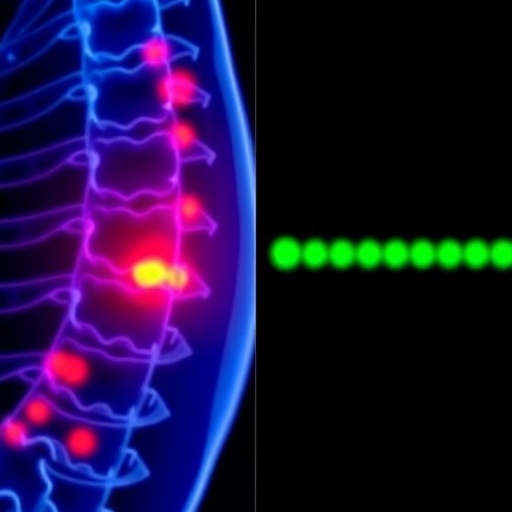The gene TP53, often referred to as the “guardian of the genome,” has long fascinated scientists because of its critical role in cellular regulation and tumor suppression. Mutations in TP53 are infamous for their association with a wide array of cancers, both sporadic and inherited. Now, groundbreaking research has uncovered an astonishing new layer of complexity in how different TP53 variants influence the risk and manifestation of diseases in carriers, particularly shedding light on a subgroup that is highly vulnerable to osteosarcoma, a rare and aggressive bone cancer.
A recent publication in Nature Communications by Fischer et al. has revolutionized our understanding of TP53 germline mutations. Their study meticulously examined variant clusters of this gene and how these clusters correlate with clinical diversity among carriers. Unlike previous research that treated TP53 mutations in a binary fashion — pathogenic versus benign — this new approach reveals nuanced subtypes of variants, each linked to distinct phenotypic outcomes. The team’s intricate analyses have paved the way for stratified medicine, where a patient’s unique TP53 mutation can help predict clinical risks and tailor surveillance protocols more effectively.
TP53 plays a pivotal role in maintaining genomic integrity by regulating cell cycle arrest, DNA repair, and apoptosis. When this gene mutates, it loses its tumor-suppressing capabilities, leading to unchecked cellular proliferation. This phenomenon is well documented in Li-Fraumeni syndrome (LFS), a hereditary cancer predisposition disorder linked to germline TP53 mutations. Yet, not all mutations behave equally in LFS patients. The study by Fischer and colleagues challenges the one-size-fits-all clinical approach by showing that variant clusters of TP53 differ significantly not only by their genetic features but also by their clinical ramifications.
Through a comprehensive assessment of germline TP53 variant carriers, the researchers identified distinct clusters that explain the phenotypic diversity observed among these individuals. Importantly, one subtype of these clusters is characterized by a strikingly high predisposition to osteosarcoma. Osteosarcoma, arising most commonly in adolescents and young adults, is notoriously difficult to predict and treat, making this discovery a critical breakthrough. This cluster distinction highlights an osteosarcoma-prone subgroup that had previously eluded categorization under existing LFS diagnostics and risk assessments.
The implications of these findings are multifaceted. Firstly, they offer an explanation for why patients harboring different TP53 mutations experience widely varied clinical courses. For clinicians, this translates to improved stratification strategies, enabling more personalized monitoring for malignancies and targeted intervention based on the patient’s specific TP53 variant cluster. Secondly, this opens avenues for precision oncology, where therapies can be adapted depending on the molecular signature of the variant cluster, potentially improving outcomes for high-risk patients.
Mechanistically, the team explored how these variant clusters influence cellular pathways differently. Using state-of-the-art genomic and proteomic techniques, it emerged that certain TP53 variants disrupt regulatory networks more profoundly, triggering oncogenic pathways that facilitate tumorigenesis in bone cells more aggressively. This mechanistic insight is crucial for drug development efforts aimed at “rescuing” or bypassing the defective p53 function inherent to these variant clusters.
The researchers further leveraged deep sequencing data from large cohorts of germline TP53 carriers worldwide, combining genotype-phenotype correlations with advanced bioinformatic modeling. This integrative approach allowed for robust identification of variant cluster-specific signatures, revealing a genetic landscape far more complex than previously recognized. It challenges the traditional pathogenicity scoring methods, which often fail to account for contextual effects of variant clustering on tumor spectrum and age of onset.
Fischer et al.’s work also underscores the value of international data-sharing initiatives and collaboration in rare disease genomics. In pooling datasets from diverse populations, the team was able to achieve sufficient statistical power to discern subtle yet clinically meaningful differences between variant clusters. This exemplifies how contemporary cancer genetics demands both broad-scale data integration and sophisticated computational tools to unlock hidden genotype-phenotype relationships.
One of the most compelling aspects of the study is its potential clinical translatability. Incorporating variant cluster analysis into clinical genetic testing protocols could revolutionize counseling for TP53 carriers. Families with osteosarcoma-prone clusters would benefit from heightened surveillance protocols, early detection strategies, and perhaps even proactive therapeutic measures. This marks a transition from reactive to predictive oncology in hereditary cancer syndromes.
Beyond the immediate clinical impact, this research invites deeper inquiry into tumor biology and evolutionary dynamics of cancer. Understanding why certain TP53 variant clusters preferentially lead to osteosarcoma could illuminate fundamental principles governing tissue-specific oncogenicity. It raises tantalizing questions about cell-type vulnerability, microenvironmental factors, and the interplay between inherited mutations and somatic alterations in osteogenic cells.
Critically, the study also highlights the importance of nuanced genetic counseling. The varying penetrance and expressivity of TP53 variants mean that patients and families face complex risk calculations that must be transparently communicated. The identification of high-risk variant clusters provides a framework to discuss prognosis, lifestyle adjustments, and potential participation in clinical trials, all within a scientifically grounded context.
As the field advances, the integration of TP53 variant cluster analysis with emerging multi-omics datasets, such as epigenomics and metabolomics, could further refine predictive models. This holistic view may unearth biomarkers to track disease progression or response to treatment, enabling dynamic management strategies tailored to the molecular portrait of the individual’s variant cluster.
Furthermore, this breakthrough strengthens the biological paradigm that not all oncogenic mutations are created equal. Cancer is a mosaic disease dependent on nuanced genetic interactions and temporal dynamics. TP53, as a master regulator mutated in nearly half of all human cancers, serves as a prime model for understanding the diversity of mutation-driven disease trajectories.
In conclusion, Fischer et al.’s identification of TP53 variant clusters reshapes the landscape of germline cancer risk assessment and personalized oncology. By revealing an osteosarcoma-prone subgroup among TP53 mutation carriers, their work delivers crucial mechanistic insights and practical tools to improve patient outcomes. This research exemplifies the future of precision medicine—where genetics, advanced analytics, and clinical expertise converge to turn molecular complexity into actionable healthcare intelligence.
The discovery heralds a new era in hereditary cancer syndromes, setting a precedent for similar investigations across other tumor suppressor genes. Moving forward, routine clinical incorporation of variant cluster analysis promises to transform how we predict, prevent, and treat genetically driven cancers, offering hope to patients and families worldwide facing the formidable challenge of TP53-related disease.
Subject of Research: Genetic variant clusters of the TP53 gene and their impact on phenotypic diversity and cancer predisposition, focusing on osteosarcoma risk in germline carriers.
Article Title: TP53 variant clusters stratify phenotypic diversity in germline carriers and reveal an osteosarcoma-prone subgroup.
Article References:
Fischer, N.W., Ong, N., Laverty, B. et al. TP53 variant clusters stratify phenotypic diversity in germline carriers and reveal an osteosarcoma-prone subgroup. Nat Commun 16, 8546 (2025). https://doi.org/10.1038/s41467-025-63528-6
Image Credits: AI Generated
Tags: cancer predisposition syndromesclinical implications of TP53 variantsgenomic integrity and DNA repairgermline mutations in cancerosteosarcoma risk factorsphenotypic diversity in cancerprecision medicine in cancer treatmentrare bone cancersstratified medicine in oncologyTP53 gene mutationsTP53 variant clusterstumor suppression mechanisms





